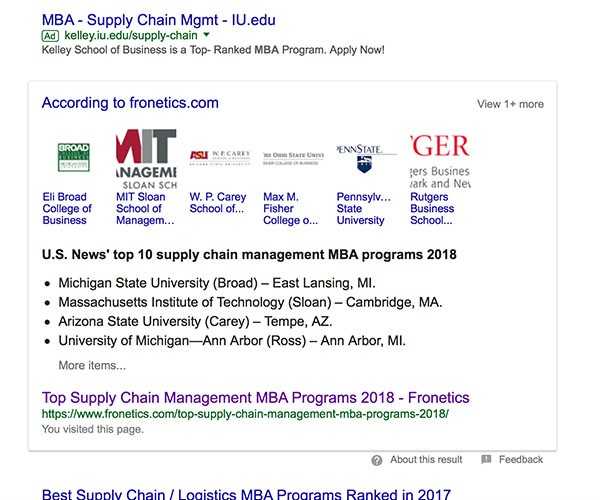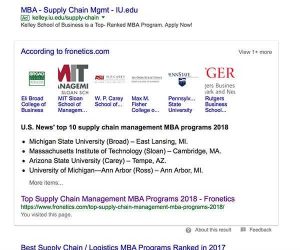
by Fronetics | Jan 3, 2018 | Blog, Content Marketing, Marketing
In part one of a four-part series on writing for SEO, we address how search engines and the search landscape have changed recently.
Content marketing has seen a lot of changes in the past few years. These changes are largely results of the rapidly evolving search landscape, as well as a seismic shift in the way people are actually discovering content. New, more sophisticated search algorithms, changes in the way people use search engines, and new ways that marketers develop their content are just a few of the contributing factors and outcomes.
Over the next few weeks, we’ll be writing a series of posts examining how marketers should approach writing for SEO in this new landscape. Today, we’re exploring specifically how search engines have evolved — something they are always doing, as they improve to help searchers find the content that best answers their queries.
Are keyword rankings still important?
It’s important to recognize that as search engines change the way they process and evaluate content, older metrics of SEO success aren’t as reliable as they used to be. Take keyword rankings for example. While conventional wisdom tells us that it’s absolutely necessary for content marketers to check their Google keyword rankings for target keywords, debate has swirled recently about the actual reliability of this metric.
Why is this once-standard metric being called into question? The answer is largely about context: Search engines have evolved beyond the point where everyone gets the same results of a query, and therefore rank can change drastically depending on context.
Location-based searches are one of the most obvious and important contextual variables. Simply put, depending on where you’re searching from, you’ll see different search results. This makes it difficult and unreliable to evaluate success based on keyword rankings alone.
Featured snippets
In addition to keyword-ranking problems, search engines are starting to dictate how content should be structured — particularly with the increased appearance of featured snippets. These snippets typically display content from within one of the pages ranking on page one of a question-based query, directly answering the question searched for without the user ever having to visit the actual page.

Fronetics has the featured snippet for Supply Chain Management MBA Programs.
A recent study found that of 1.4 million queries, 30% showed a featured snippet — that’s big growth. This means that content that ranks within the featured snippet section often gets a much greater share of the traffic for the given query. For content creators, this points to a need to restructure content to try to appear within these featured snippets.
Changes to the way search engines work do present a challenge for content creators writing for SEO. But keeping pace with the ever-changing technology is key to keeping your content relevant.
Make sure to check out part 2 in our series, Writing for SEO: People Are Changing How They Search, part 3, Writing for SEO: Topic Clusters and Pillar Content (NOT Keywords), and part 4, Writing for SEO: Measuring the Success of Your Content.
Related posts:

SaveSave

by Fronetics | Jan 2, 2018 | Blog, Content Marketing, Logistics, Marketing, Social Media, Supply Chain
It’s time to cast your vote for the top logistics and supply chain blogs of 2018!
We love hearing about your favorite logistics and supply chain blogs. We’re conducting our 4th annual survey to uncover the top industry blogs of 2018. Help us by voting for your favorite. Responses will be collected through Friday, January 26, 2018.

All responses are confidential and will be reported in aggregate. No identifiable information (individual or company) will be attached or included. Please contact [email protected] with any questions.
Interested in our past winners? Here they are!

SaveSave

by Fronetics | Dec 12, 2017 | Blog, Content Marketing, Marketing
Our most-viewed content marketing posts indicate that marketers are seeking solutions to improve their content marketing programs.
Supply chain and logistics marketers are increasingly seeing the value of content marketing. It is the most cost-effective method to earn leads and sales because it takes into account the way modern B2B buyers are making purchasing decisions (evaluating content they find on the internet).
Looking at our most-viewed content marketing posts this year, I see a trend: marketers are looking for solutions to improve their content marketing programs. I am currently working on our content calendar for 2018, so if there is anything specific you would like to know about, please feel free to email me with suggestions!
Top 10 content marketing posts
1) 4 Ways to Measure Brand Awareness
Building brand awareness is one of the key benefits of content marketing, but it’s notoriously difficult to measure. These four metrics can indicate that you are successfully drawing the public’s attention to — and heightening their knowledge of — your business. That will ultimately generate leads that turn into sales, which is the end marketing objective. Read full post
2) How to Write Better Headlines for LinkedIn Content in 2017
A study of 2016’s most popular content on LinkedIn used data to measure the most popular headlines and topics. The results are really interesting and say a lot about what content resonates with the general LinkedIn community. Tis post summarizes the most popular headline phrases and the most impactful headline words and topics, and suggests ow to use this knowledge to write more successful headlines for your LinkedIn content. Read full post
3) 4 Steps to Building a Successful DIY Content Marketing Strategy
Setting your content marketing strategy is a crucial first step in trying to reach your target audience. Before you begin writing blogs and posting tweets, you need to set goals. A content marketing strategy outlines the methods by which you will target, reach, and engage your audience. Here are four steps, outlined in the guide, to creating a successful foundation to your content marketing strategy. Read full post
4) Want More Leads? Write Better Content
All too often, marketers fall into the trap of sacrificing quality for quantity in their content writing efforts. It’s an easy mistake to make — the pressure to produce a constant stream of content can naturally lead to a drop in quality. But if you’re not writing high-quality, substantive content, you’re wasting time and energy. If you’re wondering whether your content might not measure up, ask yourself these six questions. Read full post
5) 7 Marketing Tasks Supply Chain and Logistics Companies Should Consider Outsourcing
Everyone needs a little help sometimes. In fact, 52% of B2B marketers attribute stagnancy in success to not having enough time devoted to their marketing programs, and 49% attribute stagnation to content creation challenges. Outsourcing marketing allows you to focus on insourcing your core competencies while delegating specialized tasks to external experts. And it’s important to note that you don’t have to outsource ALL of your marketing. Choosing several areas beyond your staff’s expertise or that are particularly time-consuming can help you improve your marketing efforts and take stress off an overworked internal marketing team. Read full post
6) 10 Stats You Should Know about the B2B Buyer’s Journey
Marketers need to be aware of the ways in which the B2B buyer’s journey has changed over the last decade. The vast amount of information available on the internet has afforded buyers a level of self-sufficiency that renders traditional sales models moot. It drives the need for new strategies, like content marketing and social media marketing. The latest B2B Buyer’s Survey offers insight into how B2B buyers are finding vendors, engaging with them, and — ultimately — deciding to work with one. Read full post
7) 3 Tools for Measuring Your Content Marketing ROI
Analyzing the right metrics is crucial to determining whether you are achieving content marketing ROI. According to our Social Media Use Report, 81% of respondents wanted a tracking and measuring tool to prove their ROI. Your resources are limited, so it’s crucial to evaluate your efforts with meaningful numbers that illustrate their effect on your bottom line. So what are they best metrics to use? Here are three of our favorite tools. Read full post
8) 3 Content Marketing Challenges Large B2B Enterprises Face
B2B enterprises with 1000+ employees face unique content marketing challenges that can hinder a program’s overall success. The Content Marketing Institute’s 2017 B2B Enterprise Content Marketing Report brings many of these issues to light. For example, pressure to produce results quickly is a death sentence for content marketing. And being forced to create content for a brand, rather than a specific audience, can be detrimental to content marketing results. Yes, challenges facing these enterprise marketers are often as large as the companies for which they work. This post looks at some of the reasons why that is, and a few solutions for solving them. Read full post
9) How Word of Mouth Can Work for You
Buyers value the opinions of peers and colleagues. In fact, B2B buyers rank it among their top three resources for information. And, in general, 82% of Americans seek recommendations when making a purchase of any kind. Make their chatter work for you. Here are three tips to turn word-of-mouth marketing into leads. Read full post
10) 3 Quick SEO Tips to Improve Your Blog Right Now
Content marketing aims to draw potential buyers who are searching the internet for products and services like yours to your website. The strategic distribution of content helps search engines understand what your website is all about and direct relevant parties to it. You can help the search engines’ algorithms more effectively link searchers and your content by doing these 3 easy things. Read full post
Related posts:


by Fronetics | Dec 5, 2017 | Blog, Content Marketing, Current Events, Logistics, Marketing, Supply Chain
Companies in the supply chain and logistics industries should take note of these 4 trends that are gaining traction as we move into 2018.
Joe Pulizzi of the Content Marketing Institute recently revealed his predictions for the biggest trends in content marketing for 2018. As the founder of CMI, Pulizzi dedicates his time discussing how content marketing has evolved with leading marketers from around the world and keeps his finger on the pulse of content marketing trends.
Most of the predications we discussed for 2017 are still holding true as we roll into another calendar year. Supply chain and logistics companies are still working overtime to nail down a true content marketing strategy. Native advertising is still the “gateway drug” to content marketing. And the growing dependence on mobile devices has continued to skyrocket.
What does this mean for 2018?
The key trends from 2017 continue to highlight the importance of good content. With over one million new-data-producing social media users each day, high-quality content is the only way to stand out from the masses. As you start to strategize for next year, and beyond, be sure to consider these trends in your supply chain marketing plans.
4 content marketing trends for 2018
1. Original content is king
A recent report claims that Apple is planning to invest over $1 billion on original content. Why the hefty price tag? As competition in the mobile space continues to heat up, brands need to do more to stay relevant. Valuable, original content can help companies like Apple grow its audience and keep its current customers coming back for more.
What does this mean for you? Pulizzi believes that this trend will offer companies multiple options to monetize their content. Either through direct sales to customers or advertising and sponsorship opportunities, supply chain and logistics companies will be able to cash in on their original content.
Make sure to keep a close eye on your competitor’s content. More and more companies will see the value in original content and look to build loyalty and support from their growing audience.
2. Creating vs. purchasing
For those supply chain and logistics companies that don’t have the time or resources to invest in creating original content, acquisitions will offer a pricey solution. 2018 will see a spike in content marketing brand acquisitions, giving companies full-service content options. Back in August, Netflix acquired Millarworld, a comic book publisher, hoping to gain traction with cutting-edge content in a host of different mediums.
While 62% of companies outsource their content marketing, the rise in acquisitions highlights the value of content creation and distribution. The decision to create content vs. buy will depend on the size of your wallet.
3. Content marketing budgets on the rise
According to Marketingmag.com, content marketing will become a $300 billion industry by 2019. That’s a lot of money being spent on content creation and distribution, which can only mean one thing: content marketing budgets are increasing. 39% of marketers expect their content marketing budgets to increase this year.
More brands are seeing the effectiveness of content marketing over traditional advertising. Moving away from traditional advertising and optimizing your content marketing strategy will make your marketing budget dollars stretch further and work harder in getting your content in front of the right people.
4. Content marketing overlap
Many of us are familiar with Marcus Sheridan’s story about the success of his pool company and starting the Sales Lion. Desperate to save his company, Sheridan threw himself into content marketing and created the most-visited swimming pool website in the world. Sheridan’s biggest take away? Marketing is a team sport. “Want content marketing to work? Involve everybody on your teams,” writes Sheridan.
Content marketing doesn’t work in a silo and without leadership. For content marketing to be most effective, leaders need to give clear ownership to someone over your content marketing strategy. From there, everyone needs to get on board, creating a culture of content. Your sales teams should integrate your content marketing into their sales processes. Your PR team should meet regularly with your social media experts.
“To say you have a culture of content is to say that everyone who works for your company understands the value of the information you provide and participates in making that information useful,” writes Marcia Reifer Johnston.
Overlap is bound to happen in your content marketing endeavors. The key is to have clear leadership over your strategy and regularly communicate your goals and initiatives, so your entire team can be engaged in your efforts.
Related posts:


by Fronetics | Nov 29, 2017 | Blog, Content Marketing, Current Events, Marketing, Social Media
Also in social media news November 2017: Snapchat opens conversation tracking “Snap Pixels,” Facebook links Messenger to your News Feed Ads, and Instagram Stories hits 300 million daily active users.
The holidays have everyone thinking about shopping and meal planning, but social media is staying focused on expanding and improving. There’s been a big push by the most popular sites to introduce users to new content. And businesses are seeing increased options for getting in front of potential customers.
Here’s your social media news for November 2017.
Facebook Rolls Out Its Self-Discovery “Explore Feed”
Facebook has officially rolled out its new Explore Feed, which will help users discover more content across the social media network. Explore will recommend content that it thinks you might find interesting, including posts, articles, photos and videos from users and Pages that you don’t currently follow.
“We’ve heard from people that they want an easy way to explore relevant content from Pages they haven’t connected with yet,” says Facebook in a statement on their website. Businesses should be optimistic about the potential for users interested in content like theirs to find their pages through the new Explore Feed.
On mobile, the Explore Feed is accessible via the “More” menu in the bottom navigation section, while it’s housed along the left sidebar within the “Explore” section on desktop.
Instagram Stories Expands to Your Camera Roll
Instagram Stories now allows users to upload any photos and videos from their cameras. In the past, Instagram limited Stories to photos and videos taken in real time to give viewers “glimpses” into a user’s day. The social media network felt this update offers more flexibility and creative choices to its users.
Twitter Launches Self-Serve Advertising
Twitter has officially rolled out its self-serve advertising subscription to the public. Twitter’s Promote Mode will automatically amplify a business’s tweets to reach the best audience and grow followers. Promote Mode was designed with the goal of letting small businesses and personal brands more easily run ad campaigns on Twitter’s platform by automating them, for the price of $99 per month.
Facebook Messenger Makes Sponsored Messages Available to Businesses
Facebook announced that in the next few months advertisers will be able to send promotions to customers who have previously communicated with the brand directly through Messenger. “When it comes to communicating with a brand, 54.4% of U.S. social media users said they preferred messaging channels, including Messenger, over email, phone and online chat,” writes Facebook on its website. Facebook’s goal is to create a more personalized experience for customers by having promotions come through Messenger, instead of on a generic post.
Facebook Rolls Out News Feed Ads that Link to Messenger
With Facebook’s new messaging platform, businesses and developers can take the customer experience to a new level by creating news feed ads that directly open to Messenger conversations. According to Facebook, this new ad format “combines the powerful audience targeting and selection capabilities of ads on News Feed” with “the identity and canonical nature of Messenger conversations” and is available to all Facebook advertisers.
Instagram Stories and WhatsApp Status Hit 300 Million Daily Active Users
Up over 50 million daily active users since June, Facebook reports that Instagram Stories and WhatsApp Status have reached 300 million daily active users. These numbers are almost double SnapChat’s daily active users, once again showing the increasing popularity of Facebook and its counterparts.
Facebook Rolls Out Facebook Polls with Photos
Always wanted to know what people think about your brand and your competitors? Now creating polls to get the answers is easier than ever. Facebook officially launched Facebook Polls with the option to add pictures or GIFs. Businesses will be able to track polls about their products or services, as well as the feedback. “Facebook Polls will provide an easy way to spur conversation, gather opinions or organize plans.”
SnapChat Opens Conversation Tracking “Snap Pixel” to Marketers
SnapChat recently introduced Snap Pixel, a conversation tracking tool that allows brands to measure the effectiveness of video snap ads on their site traffic. Marketing Land reports that the new Snap Pixel will soon be available to all advertisers as a measurement tool and for retargeting purposes by the end of the year.
Related posts:


by Fronetics | Nov 20, 2017 | Blog, Content Marketing, Marketing, Social Media
Measuring brand awareness has been notoriously difficult. But these 4 metrics can help you evaluate if potential customers are encountering your content.
Companies work hard to get their products and services out into the world. It’s a key step in gaining exposure among potential customers and earning new business. This process is called brand awareness, the extent to which consumers are familiar with your brand.
Heightening the public’s knowledge of your business will generate leads, some of which will turn into sales. But this knowledge, or brand awareness, has proven difficult to measure. Do potential customers know your name, what you sell, and where to contact you? Creating ways to measure how recognizable your business is will show you what people think of your company, as well as where you should be focusing your time and money to help grow your exposure.
Here are 4 metrics to measure your brand awareness.
1. Social media reach
The larger your social media reach, the larger the potential audience. The reach of your social media content has a big impact on your brand awareness. Tracking engagements on each network will help you measure progress, build a greater following, and, ultimately, generate more site visits.
Use tools like Sharedcount, a free online tool that tracks the number of times a piece of content has been shared on the most popular social media sites — including Facebook, Twitter and LinkedIn — to easily keep track of your social reach.
2. Blog shares
Your blog content is the perfect fodder for organic brand awareness, especially if sharing your posts is easy. Create a share bar on your blog to allow your readers to quickly share your content through social media networks. Measure your number of shares to track your most popular blogs, monitor your growing brand awareness, and help guide the topics of your future blog posts.
3. Brand mentions
Are customers talking about your brand online? There’s a great deal of value in knowing what they’re saying. Monitoring brand mentions online can provide honest feedback and objective insight from current and potential customers.
There are several tools to help you track brand mentions online. Here at Fronetics, we prefer the ease of Google Alerts, which allows you to set up custom alerts when your brand is mentioned online. We also use Hootsuite, where you can track brand mentions, as well as keywords and phrases across all of your social media platforms.
4. Website traffic
Every visit to your website represents someone who is familiar with your brand. The question is: How are people finding your website? Think of web traffic in terms of sources:
- Organic traffic – users come across your website from search engines
- Direct traffic – users type in the name of your website or brand directly
- Referral traffic – users find your website from links on other websites
- Social traffic – users come across your website from social media content
- Paid search/social – users click on one of your paid digital ads, which drives them to your site
- Email traffic – users click through one of your marketing emails
You’ll want a healthy balance of each source to ensure your brand awareness campaign is diversified. Measure each of these metrics using a platform like Google Analytics or HubSpot. As each grows, you’ll know your brand awareness is growing alongside.
Use these 4 metrics to measure your brand awareness and track your progress as you work to grow your exposure. See where you’re having the most success and where you need improvement, and adjust your strategy accordingly.
Related posts:











